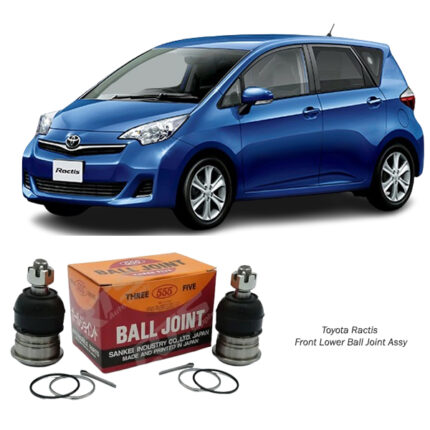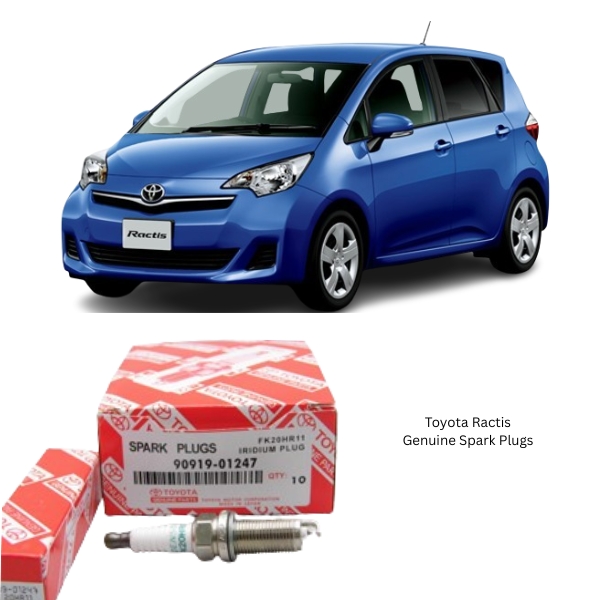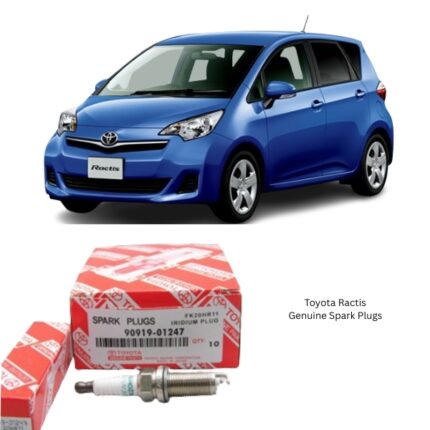Get Toyota Ractis Genuine Spark plugs FK20HR11 in Kenya
Spark plugs are one of the most vital components in a petrol-powered engine, playing a central role in the combustion process that powers the vehicle. Genuine spark plugs—designed and manufactured specifically to meet original equipment (OE) standards—offer unmatched reliability, efficiency, and performance. Whether in a small commuter car, a high-performance sports car, or a heavy-duty truck, the quality of the spark plug determines how well the engine runs, how smoothly it starts, and how efficiently it consumes fuel.
What Are Spark Plugs?
A spark plug is an electrical device that fits into the cylinder head of an internal combustion engine and ignites the air/fuel mixture with a timed electric spark. This spark is critical for initiating combustion inside each cylinder. Each engine cylinder has a dedicated spark plug, and the condition of these plugs directly affects engine performance, fuel economy, and emissions.
The spark plug must withstand extreme conditions—including very high pressure and temperature—while delivering precise, consistent sparks at high frequencies, often thousands of times per minute.
What Makes a Spark Plug “Genuine”?
A genuine spark plug is an OE-spec (Original Equipment Specification) product manufactured or endorsed by the vehicle manufacturer or by an authorized OE supplier. These plugs are designed to the exact specifications required by the engine, including:
-
Thread diameter and pitch
-
Reach (length of threaded portion)
-
Seat type (gasket or taper)
-
Hex size
-
Heat range
-
Electrode configuration
-
Material of the center and ground electrodes
Genuine spark plugs are rigorously tested for durability, performance, and compatibility, ensuring they meet the precise requirements of your engine.
Construction and Design
Genuine spark plugs are built using high-grade materials and precise manufacturing processes to ensure longevity and peak performance. Key components include:
1. Terminal
This is the topmost part of the plug, connecting it to the ignition coil or spark plug wire.
2. Insulator
Made of high-purity ceramic, the insulator prevents high voltage from escaping and dissipating before reaching the electrode gap. It also helps the plug resist heat and vibration.
3. Metal Shell
The threaded metal shell ensures a tight fit into the engine’s cylinder head and helps dissipate heat from the plug into the cooling system. It may also include a hex nut for installation and removal.
4. Center Electrode
Typically made from copper, nickel alloy, platinum, or iridium, the center electrode is responsible for conducting high-voltage electricity into the combustion chamber.
5. Ground Electrode
Attached to the metal shell, this forms the opposite side of the spark gap. Its position and shape influence the quality of the spark.
6. Gasket or Tapered Seat
Used to seal the combustion chamber and prevent gas leaks.
Electrode Materials in Genuine Spark Plugs
Genuine spark plugs are often made using advanced materials to improve longevity and performance:
-
Copper Core: Excellent conductor of electricity and heat, but wears faster.
-
Platinum Tip: Resists wear better than copper and provides longer service life.
-
Iridium Tip: Even harder and more durable than platinum, often found in high-performance or modern engines.
-
Double Platinum or Iridium: Both center and ground electrodes are tipped, increasing durability and performance further.
Heat Range Explained
The heat range of a spark plug refers to how well it dissipates heat from the tip into the engine’s cylinder head. A plug that stays too hot can pre-ignite the fuel-air mixture, causing knocking. A plug that runs too cold can foul from carbon build-up. Genuine spark plugs are selected with the ideal heat range for your engine, ensuring optimal performance and reliability.
Functions of Genuine Spark Plugs
-
Ignition of Air-Fuel Mixture: Delivers a powerful, consistent spark to ignite the mixture, beginning the combustion process that powers the vehicle.
-
Heat Dissipation: Transfers combustion heat from the tip to the cylinder head to prevent overheating.
-
Sealing the Combustion Chamber: Helps maintain compression by sealing the combustion chamber when tightened properly.
-
Support for Engine Sensors: In modern engines, spark plugs are designed to work in harmony with electronic ignition systems and engine control units.
Benefits of Using Genuine Spark Plugs
1. Precise Fit and Compatibility
Genuine plugs are specifically engineered for the engine’s design. They ensure perfect fitment, optimal electrode positioning, and the correct spark gap.
2. Reliable Performance
OE spark plugs are tested under harsh operating conditions. They provide consistent ignition performance across the vehicle’s rev range, including cold starts, idling, and high-speed driving.
3. Longevity
Made from high-quality materials like iridium or platinum, genuine plugs offer a longer service life—often 60,000 km to 100,000+ km depending on the material and engine conditions.
4. Fuel Efficiency
Accurate combustion reduces unburnt fuel, improving miles per litre and lowering emissions.
5. Engine Protection
Properly designed and calibrated spark plugs prevent issues such as misfiring, knocking, and carbon fouling, reducing long-term engine wear.
When to Replace Spark Plugs
Over time, spark plugs wear out due to erosion of the electrodes, carbon deposits, and exposure to high temperatures. Symptoms of worn or failing spark plugs include:
-
Rough idling
-
Engine misfires
-
Poor fuel economy
-
Difficulty starting the engine
-
Hesitation or power loss during acceleration
-
Increased emissions
It’s recommended to follow the manufacturer’s service interval for replacement, typically between 30,000 to 100,000 km, depending on the type of spark plug and engine design.
Installation Considerations
Installing spark plugs requires proper tools and torque specs to avoid damaging the plug or engine. Key considerations include:
-
Spark plug socket with a rubber insert to protect the ceramic insulator.
-
Torque wrench to tighten to manufacturer specifications.
-
Dielectric grease for moisture resistance on the boot (optional).
-
Correct spark gap, as recommended in the service manual (though most genuine plugs come pre-gapped).
Over-tightening can strip the threads or crack the insulator, while under-tightening can result in poor heat transfer or compression leaks.
Maintenance Tips
-
Regular Inspections: Check spark plugs at intervals to assess wear or fouling.
-
Cleanliness: Avoid letting dirt fall into the cylinder when removing plugs.
-
Gap Checking: Use a feeler gauge to ensure the correct gap if adjusting.
-
Replacement in Sets: Always replace all spark plugs at once to maintain consistent engine performance.
Genuine vs. Aftermarket
While aftermarket spark plugs may fit, they often do not match the material quality, engineering precision, or reliability of genuine parts. Inferior plugs can lead to misfires, reduced engine performance, and even long-term damage. Genuine plugs are tested to exacting standards and are the safest choice for maintaining manufacturer-grade performance.
Follow us on Facebook for more parts.




